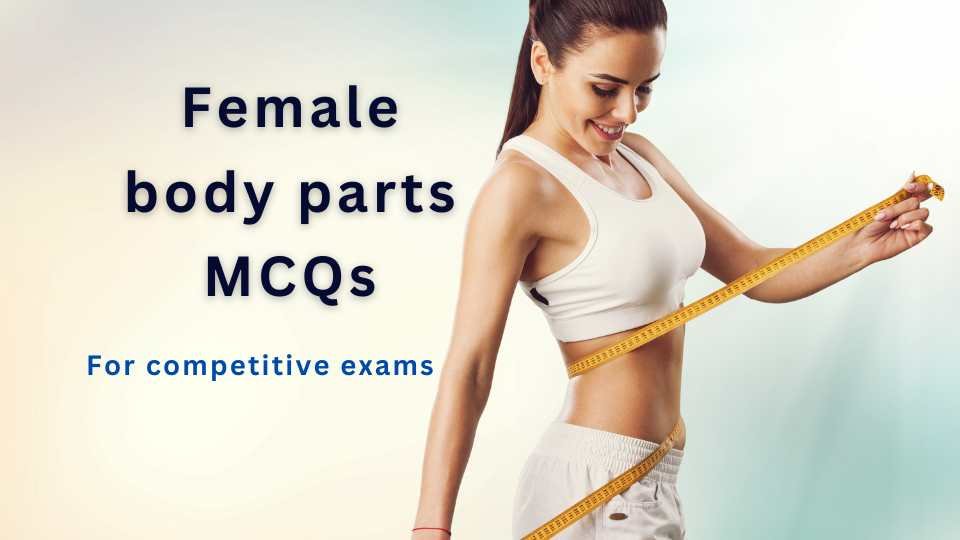Understanding the female body and its anatomy is essential for a wide range of competitive exams, particularly those focused on medical, biological, and health sciences. These Multiple Choice Questions (MCQs) cover various aspects of the female body, including anatomy, physiology, and common health conditions.

1. What is the primary function of the female reproductive system?
A) Digestion
B) Circulation
C) Reproduction
D) Excretion
Answer: C) Reproduction
Description: The primary function of the female reproductive system is reproduction, enabling childbirth and the continuation of species.
2. Which hormone imbalance commonly causes body odor in females?
A) Insulin
B) Estrogen
C) Adrenaline
D) Serotonin
Answer: B) Estrogen
Description: Hormonal fluctuations, particularly involving estrogen, can cause changes in body odor during menstruation, pregnancy, or menopause.
3. What type of body shape is classified as “broad body type female”?
A) Pear-shaped
B) Hourglass-shaped
C) Broad shoulders with narrow hips
D) Slim
Answer: C) Broad shoulders with narrow hips
Description: Females with a broad body type typically have wide shoulders and a narrower lower body.
4. Where is the female pelvis located?
A) Chest
B) Abdomen
C) Below the abdomen, connecting the spine to the legs
D) Neck
Answer: C) Below the abdomen, connecting the spine to the legs
Description: The pelvis in females is located below the abdomen and plays a key role in childbirth and supporting the body’s weight.
5. What is an “abstract female face”?
A) A realistic depiction of a woman’s face
B) A detailed sketch of a female face
C) A stylized or symbolic representation of a female face
D) A female face made of geometric shapes
Answer: C) A stylized or symbolic representation of a female face
Description: Abstract female faces are often created using artistic styles that represent emotions or ideas rather than realistic appearances.
6. Which body part stores fat around the waist in females?
A) Hips
B) Belly
C) Neck
D) Arms
Answer: B) Belly
Description: Belly fat is commonly stored in the waist area due to hormonal influences, diet, and lifestyle factors.
7. What is the average body weight range for adult females?
A) 100-150 pounds
B) 200-250 pounds
C) 300-350 pounds
D) 400-450 pounds
Answer: A) 100-150 pounds
Description: The average body weight for adult females typically falls within the range of 100-150 pounds, although this can vary based on factors such as height and muscle mass.
8. Which organ regulates female hormone balance?
A) Lungs
B) Kidneys
C) Ovaries
D) Brain
Answer: C) Ovaries
Description: The ovaries are responsible for producing estrogen and progesterone, which are crucial for female reproductive health and hormonal balance.
9. What causes “strong body odor” in females?
A) Sweating without hygiene
B) Hormonal imbalance
C) Diet rich in onions
D) All of the above
Answer: D) All of the above
Description: Strong body odor in females can be caused by a variety of factors, including poor hygiene, hormonal fluctuations, and certain foods like garlic or onions.
10. What is the function of female abdominal muscles?
A) Strengthening the back
B) Supporting internal organs
C) Maintaining posture
D) All of the above
Answer: D) All of the above
Description: Female abdominal muscles play a critical role in posture, supporting internal organs, and stabilizing the back during movement.
11. What is the term for the study of the structure of the female body?
A) Physiology
B) Psychology
C) Anatomy
D) Sociology
Answer: C) Anatomy
Description: Anatomy is the study of the physical structure of the body, including muscles, bones, and organs.
12. How many major body types are commonly recognized in females?
A) 1
B) 3
C) 5
D) 10
Answer: B) 3
Description: The three most commonly recognized female body types are ectomorph (slim), mesomorph (muscular), and endomorph (curvy).
13. Which face shape is most associated with attractiveness in females?
A) Round
B) Heart-shaped
C) Oval
D) Square
Answer: C) Oval
Description: Oval face shapes are often considered the most attractive due to their balanced proportions.
14. What hormone is responsible for female secondary sexual characteristics?
A) Testosterone
B) Estrogen
C) Dopamine
D) Melatonin
Answer: B) Estrogen
Description: Estrogen is responsible for secondary sexual characteristics like breast development, wider hips, and a higher-pitched voice.
15. What is the function of the chest muscles in females?
A) Supporting breathing
B) Protecting the heart
C) Stabilizing the upper body
D) All of the above
Answer: D) All of the above
Description: The chest muscles in females help support breathing, protect vital organs like the heart, and stabilize the upper body.
16. What is a characteristic of a “beautiful female face”?
A) Symmetry
B) Large eyes
C) Full lips
D) All of the above
Answer: D) All of the above
Description: Beauty in female faces is often associated with symmetrical features, large expressive eyes, and full lips.
17. What is the “gendered brain” theory?
A) Men and women have identical brains
B) Men and women have completely different brains
C) Gendered brains are shaped by social and cultural influences
D) Gender is irrelevant to brain function
Answer: C) Gendered brains are shaped by social and cultural influences
Description: The gendered brain theory suggests that gender differences in the brain are shaped by both biology and societal norms.
18. What is a typical trait of the “female human body”?
A) Narrow shoulders and wide hips
B) Wide shoulders and narrow hips
C) Broad neck and slim legs
D) Large chest and narrow waist
Answer: A) Narrow shoulders and wide hips
Description: The female human body is typically characterized by narrow shoulders and wider hips, which is a result of reproductive anatomy.
19. What body shape is described as “pear-shaped”?
A) Large upper body, narrow hips
B) Narrow upper body, wide hips
C) Even distribution of weight
D) No specific shape
Answer: B) Narrow upper body, wide hips
Description: Pear-shaped bodies are characterized by narrower shoulders and a wider lower body, often with more fat stored in the hips and thighs.
20. Which type of fat is commonly stored around the belly in females?
A) Visceral fat
B) Subcutaneous fat
C) Brown fat
D) White fat
Answer: B) Subcutaneous fat
Description: Subcutaneous fat is the type of fat commonly stored around the belly in females, contributing to body shape and insulation.
21. Which type of “cute female face” is often portrayed in cartoons?
A) Large eyes, small nose
B) Small eyes, large nose
C) Average features
D) Distorted features
Answer: A) Large eyes, small nose
Description: Cute female faces in cartoons are often depicted with large, expressive eyes and small noses, creating a youthful and appealing look.
22. What is the primary purpose of the “female mind”?
A) Problem-solving
B) Creativity
C) Emotional intelligence
D) All of the above
Answer: D) All of the above
Description: The female mind, like the male mind, is involved in problem-solving, creativity, and emotional intelligence, with unique expressions influenced by culture and biology.
23. Which part of the body is typically wider in females than in males?
A) Shoulders
B) Waist
C) Hips
D) Neck
Answer: C) Hips
Description: Females typically have wider hips than males due to the role of the pelvis in childbirth.
24. Which body type is commonly described as “athletic”?
A) Ectomorph
B) Mesomorph
C) Endomorph
D) Slim
Answer: B) Mesomorph
Description: Mesomorphs have a muscular and athletic body type, often associated with strength and physical activity.
25. What is the most common cause of “strong body odor” in females?
A) Dehydration
B) Lack of hygiene
C) Hormonal fluctuations
D) Vitamin deficiency
Answer: C) Hormonal fluctuations
Description: Hormonal changes, such as those during menstruation, pregnancy, or menopause, can significantly affect body odor in females.
26. What is the function of the female “torso”?
A) To support the limbs
B) To protect vital organs
C) To allow flexibility and movement
D) All of the above
Answer: D) All of the above
Description: The female torso serves multiple functions, including supporting the limbs, protecting vital organs, and enabling flexibility and movement.
27. What is the “belly fat type” that surrounds internal organs called?
A) Subcutaneous fat
B) Visceral fat
C) Brown fat
D) Trans fat
Answer: B) Visceral fat
Description: Visceral fat surrounds internal organs and is typically stored in the abdominal cavity, posing more health risks than subcutaneous fat.
28. Which face type is commonly used in Asian female beauty standards?
A) Oval
B) Heart-shaped
C) Round
D) Square
Answer: B) Heart-shaped
Description: The heart-shaped face, characterized by a wider forehead and narrow chin, is often considered ideal in many Asian beauty standards.
29. What is a characteristic of a “beautiful nose” in females?
A) Wide nostrils
B) Crooked bridge
C) Small and symmetrical shape
D) Large and flat
Answer: C) Small and symmetrical shape
Description: A small, symmetrical nose is often considered aesthetically pleasing and is a common standard of beauty.
30. What is the purpose of “female abdominal muscles”?
A) Support breathing
B) Protect the stomach
C) Assist with childbirth
D) All of the above
Answer: D) All of the above
Description: Female abdominal muscles have multiple roles, including supporting breathing, protecting internal organs, and aiding in childbirth.
31. What hormone primarily contributes to body hair growth in females?
A) Insulin
B) Testosterone
C) Progesterone
D) Melatonin
Answer: B) Testosterone
Description: Although testosterone is primarily a male hormone, it contributes to body hair growth in both men and women.
32. Which of the following describes the “average body weight” of a female?
A) Under 100 pounds
B) 100-150 pounds
C) 150-200 pounds
D) Over 200 pounds
Answer: B) 100-150 pounds
Description: The average body weight of a female typically ranges from 100 to 150 pounds, depending on height and body composition.
33. Which body part is typically smaller in females than in males?
A) Feet
B) Hands
C) Shoulders
D) Waist
Answer: C) Shoulders
Description: Women generally have narrower shoulders compared to men due to differences in muscle mass and skeletal structure.
34. What is the primary function of the female chest?
A) To protect the lungs
B) To support breastfeeding
C) Both A and B
D) Neither A nor B
Answer: C) Both A and B
Description: The female chest plays a key role in protecting vital organs like the lungs and supporting breastfeeding.
35. Which body type is characterized by having wide hips and a narrow upper body?
A) Apple-shaped
B) Pear-shaped
C) Rectangular
D) Hourglass
Answer: B) Pear-shaped
Description: A pear-shaped body is characterized by wider hips and a narrower upper body, typical in many females.
36. What is “female human anatomy”?
A) The study of female emotions
B) The physical structure of the female body
C) A field of sociology
D) A style of art
Answer: B) The physical structure of the female body
Description: Female human anatomy involves studying the physical structure and functions of a woman’s body, including organs, muscles, and bones.
37. What is considered a “perfect female face” in beauty standards?
A) Symmetry
B) High cheekbones
C) Small nose
D) All of the above
Answer: D) All of the above
Description: The “perfect” female face often includes features like symmetry, high cheekbones, and a small nose, according to common beauty standards.
38. Which body type typically carries more fat around the hips and thighs?
A) Mesomorph
B) Endomorph
C) Ectomorph
D) None of the above
Answer: B) Endomorph
Description: Endomorphs typically store more fat around the hips and thighs, leading to a curvier appearance.
39. Which female face shape is often associated with strength and confidence?
A) Oval
B) Square
C) Round
D) Heart-shaped
Answer: B) Square
Description: A square face shape, with a strong jawline, is often associated with strength and confidence in females.
40. Which body part is involved in female hormonal regulation?
A) Lungs
B) Liver
C) Ovaries
D) Stomach
Answer: C) Ovaries
Description: The ovaries regulate female hormones like estrogen and progesterone, which are crucial for reproductive health.
41. What is the primary function of the female torso?
A) Provide balance
B) Protect vital organs
C) Both A and B
D) Neither A nor B
Answer: C) Both A and B
Description: The female torso provides balance to the body while also protecting vital organs like the heart and lungs.
42. Which hormone affects body weight in females?
A) Dopamine
B) Estrogen
C) Melatonin
D) Serotonin
Answer: B) Estrogen
Description: Estrogen has a significant impact on body weight in females, particularly during periods like menopause and pregnancy.
43. What is a characteristic of a “sexy female face”?
A) Angular features
B) Youthful appearance
C) High cheekbones
D) All of the above
Answer: D) All of the above
Description: A sexy female face is often characterized by angular features, a youthful look, and high cheekbones, which are associated with attractiveness.
44. What is a “body type description” for females with broad shoulders and narrow hips?
A) Hourglass
B) Inverted triangle
C) Rectangle
D) Pear-shaped
Answer: B) Inverted triangle
Description: Females with broad shoulders and narrow hips have an inverted triangle body type, often seen in athletes.
45. What hormone imbalance can lead to body odor in females?
A) Testosterone
B) Insulin
C) Estrogen
D) Cortisol
Answer: C) Estrogen
Description: Estrogen imbalances can lead to changes in body odor, especially during menstruation, pregnancy, or menopause.
46. What is a characteristic of “fat females” in terms of body type?
A) Low body mass index (BMI)
B) High body fat percentage
C) Muscular build
D) Underweight
Answer: B) High body fat percentage
Description: Females with a higher body fat percentage are often classified as having a “fat” body type, which can vary depending on lifestyle and genetics.
47. What is the ideal “female weight” for height according to health standards?
A) 80-100 pounds
B) 100-150 pounds
C) 150-200 pounds
D) Over 200 pounds
Answer: B) 100-150 pounds
Description: The ideal weight for females varies based on height and health standards, but 100-150 pounds is typical for an average height of around 5’4″.
48. What is a characteristic of an “ugly female face” as per societal standards?
A) Symmetrical features
B) Large eyes
C) Distorted or unbalanced facial features
D) Smooth skin
Answer: C) Distorted or unbalanced facial features
Description: Societal standards often label distorted or unbalanced facial features as less attractive, although beauty is subjective and varies across cultures.
49. Which hormone is primarily responsible for female fertility?
A) Testosterone
B) Estrogen
C) Insulin
D) Adrenaline
Answer: B) Estrogen
Description: Estrogen plays a major role in regulating the female reproductive system and is essential for fertility.
50. Which body part is more prominent in “wide rib cage female body type”?
A) Hips
B) Chest
C) Neck
D) Waist
Answer: B) Chest
Description: Females with a wide rib cage typically have a more prominent chest, which may affect their overall body shape.
Read More!
- HR MCQ Questions with answers pdf free download
- Mcq on sales and distribution management with answers



